COLONIAL PRODUCTION
The first English speaking settlers at Jamestown in 1607
quickly realized that the lack of gold and silver might
be offset by the abundance of iron ore and trees for
making charcoal to smelt it. The first ship to return to
England did so with a load of iron ore for testing. By
1620 iron furnaces were being constructed at Falling
Creek just east of present day Richmond VA. These works
were destroyed by the Indians in 1622 an it was about 40
years before serious iron production was resumed in
Virginia. By then several of the early colonies were
producing iron.By the time of the stat of the
Revolutionary War the 13 colonies had a highly developed
iron industry. If taken as a single country they were in
the top five iron producers in the world (some say third
in terms of exports). Those in the
antique gun world who have mentioned iron being scarce
or expensive have not studied the period documentation.
One of many source documents would be the Customs Report
for exports to London and other British ports from the
colonies. These survive for most years from 1707 until
1776. The records of Virginia and Maryland are lumped
together (PA is separate but I have not studied those
records). Here are a few examples of the exports from VA
and MD to London [weights are British long tons of 2200
lbs.]:
In 1770 — 512 tons of bar iron (wrought) at 9 ½
to 10 ½ pounds (value) per ton and 1125 tons of pig
(cast iron) at 18 to 20 shillings per ton.
1771 —654 tons of bar at 9 – 11 pounds and 1857
tons of pig at 18 to 20 shillings per ton.
1772 —344 tons of bar and 1309 tons of pig (same
prices)
The Brits were buying both bar iron and pig iron from
the colonies, manufacturing it into finished goods and
selling those back to the colonies, literally, by the
boat load. The Iron Act of 1750 had been written to
encourage the American manufacture of more pig iron and
bar iron and
restrict the production of plate, sheet and nail rod. It has been
considered by some historians to be the first of those
intrusive acts that lead to the Rev War but that is, as
they say, a whole other story.
The Iron Act of 1750 is probably the source of
persistent myth that it was "illegal" to manufacture
iron in the colonies prior to the Revolution. The act
did
prohibit the building of any more rolling and slitting
mills but even this was ignored and considered
unenforceable. (top)
CAST IRON, WROUGHT
IRON and STEEL
There were three types of ferrous metal in use in the
Colonial period: cast iron (high in carbon and brittle
but excellent for making items like frying pans, Dutch
ovens, cannon balls and the cheaper grades of cannon);
wrought iron (low in carbon and very tough so excellent
for anchor chains, nails and musket barrels) and steel
(carefully controlled amounts of carbon allowed steel to
be hardened for specific uses such as knife blades,
files, saws, springs, musket ramrods and swords).
CAST IRON
Cast iron was produced at a blast furnace. Iron ore,
flux (limestone or oyster shells) and charcoal were
loaded into the top of a furnace usually made in the
form of a flat topped stone pyramid. Air blasted into
the furnace caused the fire's temperature to approach
2000 degrees, freeing the iron from the oxygen and other
minerals in the ore. It was common to fire a furnace for
days on end without letting it cool down. At intervals
liquid iron was drawn off from the bottom of the
furnace. The liquid iron flowed in channels made in the
sand floor in front of the furnace. Most of the iron was
cast into ingots called "pigs" These came in different
sizes and the bigger ones were actually called "sows"
because the smaller pigs seemed to be nursing on the
larger sow. Furnaces could also cast objects like cannon
balls, cannon and Dutch ovens by ladling iron into sand
moulds as a foundry operation.
The liquid iron was in direct contact with the burning
charcoal and that caused it to be high in carbon (4-5%).
Huge amounts of charcoal were required and it took
literally thousands of acres to make the charcoal for a
single furnace. (top)
WROUGHT IRON
There were two different ways to make wrought iron (with
many variations of each).
Wrought iron can be made directly from iron ore. The ore
is heated in a small furnace called a bloomery but it is
not completely melted. Instead a spongy mass called a
"bloom" is extracted from the fire and forged, in a
process similar to kneading bread dough, until most of
the impurities are removed. Because it was never liquid
the iron did not absorb much carbon and what was there
burned away during the repeated welding.
Colonial
Williamsburg's Anderson Blacksmith Shop experiments with
making iron in a bloomery. 2008
Wrought iron can also be made from cast (pig) iron. The
pigs are re-melted on a shallow sand lined bowl by a
blast of flame. The molten iron is stirred and the blast
burns away the carbon as it is exposed on the surface.
As the carbon content drops the melting temperature
rises until the mass is no longer liquid. The resulting
bloom is then forged into bars with large water powered
trip hammers. The more the bar is folded and
welded back on itself the more highly refined the iron
becomes. The "grain" of the iron becomes finer as the
silica inclusions become smaller and smaller.
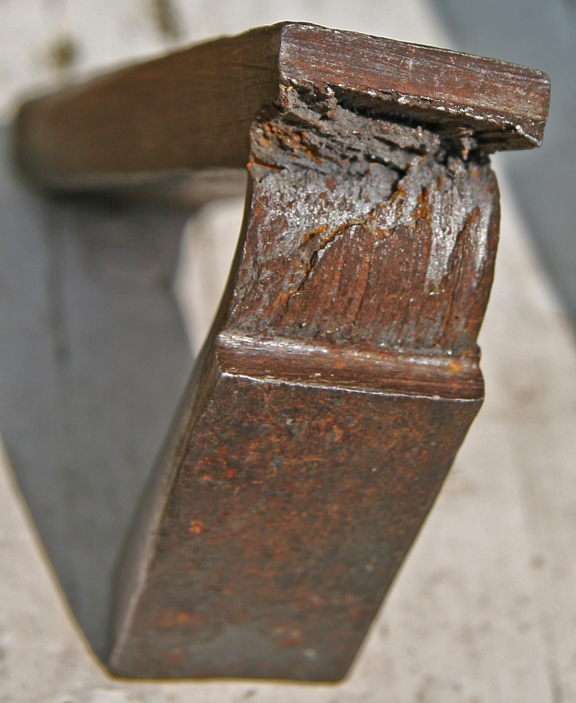
A bar of wrought iron that has been cut part way through
then broken to reveal the "grain."
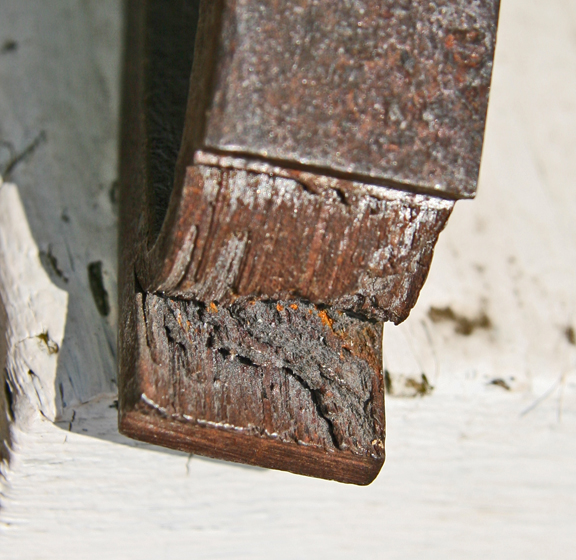
Wagon wheels, anchors' and such were made of lower
quality iron but gun barrels, lock parts (not counting
the springs) and mounts were usually made of very high quality
wrought iron. More refinement under the hammer produces
higher quality which translates to finer grain.
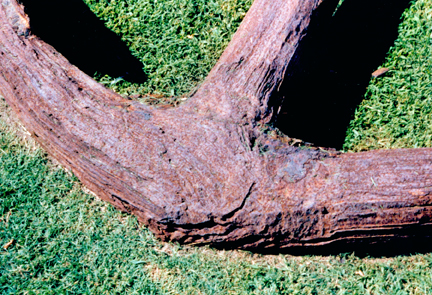
Salt water etched the wrought iron revealing a very
course grain in this anchor.
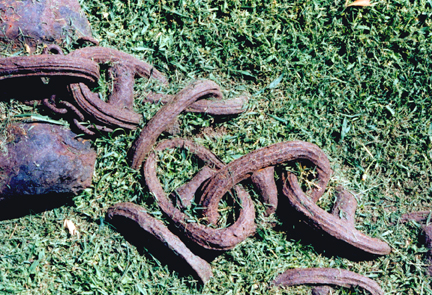
Note that the grain in the iron of the reinforcing
cross bars is perpendicular to that of the link. The
bars were separate pieces welded in place.
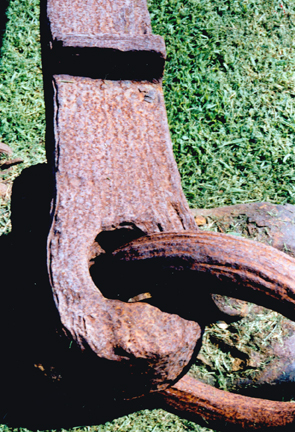
Holes such as this were much easier to hot punch than
to drill.
Wrought iron objects could be surface hardened or “case
hardened” by heating for a fairly short time in the
presence of carbon and that is how the lock parts, other
than the springs, were heat treated. That is forged,
filed, and polished in soft iron, then case hardened for
wear resistance. Depending on the temperature and the
amount time the iron is in the carbon pack, the case
hardening can penetrate deep enough to convert thin
cross sections, such as the nose of a sear, completely
to high carbon steel. (top)
STEEL
Here is the definition of steel in Samuel Johnson's 1755
Dictionary: "Steel is a kind of iron, refined and
purified by the fire with other ingredients, which
renders it white, and its grain closer and finer
than common iron. Steel, of all other metals, is that
susceptible of the greatest degree of hardness, when
well tempered; whence its great use in the making of
tools and instruments of all kinds.” "Steel is made from
the purest and softest iron, by keeping it
red-hot, stratified with coal-dust and wood-ashes, or
other substances that abound in phlogiston, for several
hours in a close furnace.”
Thin strips of highly refined wrought iron were layered
("stratified") with charcoal (often a mix of bone,
leather and wood charcoal) in a box that could be sealed
to keep air out. The box is heated to about 1500 degrees
and kept hot for many hours. The carbon soaks into the
iron and converts it to steel. The name "Blister steel"
comes from the blistered blue-gray scale that forms on
the surface of the bars. Blister steel was imported
mostly from England and Germany and available in many
colonial stores. Due to the long soak the carbon is
distributed fairly uniformly but there would be a bit
more toward the outside of the bar.
For some applications where uniformity of carbon
content was very important, blister steel could be
further refined by bundling strips together, forge
welding them into a mass and then drawing this back out
into a strip. That could be repeated several times but
that was done only for the best cutlery, razors and
clock and watch springs. Because of the intended use
this more uniform steel was called "shear steel."
In about 1739 an English watchmaker, Benjamin
Huntsman, discovered that under the right conditions
blister steel could be melted in a crucible and stirred
while liquid. This caused very uniform distribution of
the carbon. Steel made this way was called “cast steel.”
By the late 18th century "cast steel" was being used for
cutlery and chisels. Contrary to popular belief a chisel
marked "Cast Steel" was not cast! It was forged from a
bar of steel that had been made through the crucible
process. (In the early 19th century some rifle barrels
were made of cast steel but most were wrought iron until
after the Bessemer process made uniform, high-quality
steel much cheaper in the mid-19th century.)
Many objects were made of a combination of wrought iron
and the more expensive steel. Axe heads of wrought iron
had a steel bit that did the cutting. Likewise wood
chisels and plane blades had a layer of steel welded on
the side that formed the cutting edge.
(top)
|